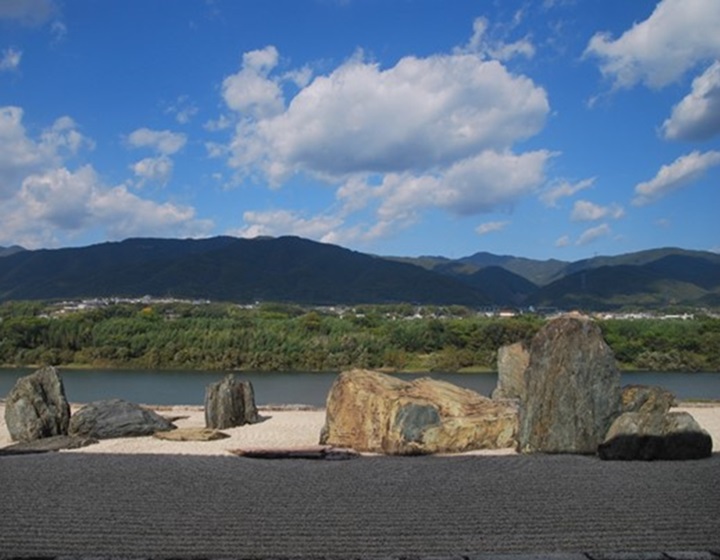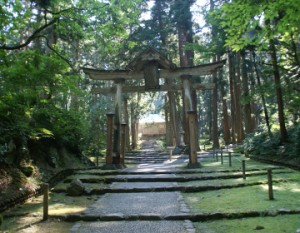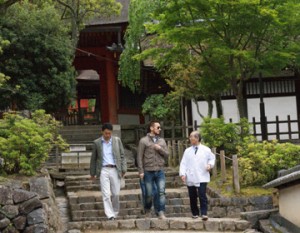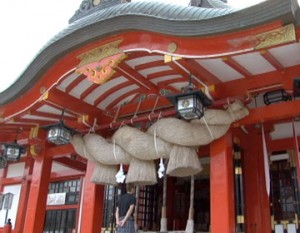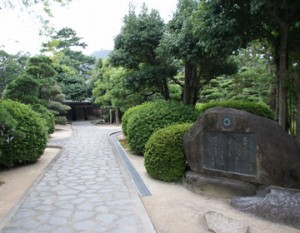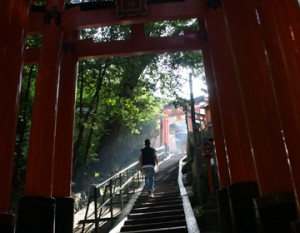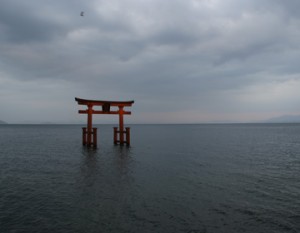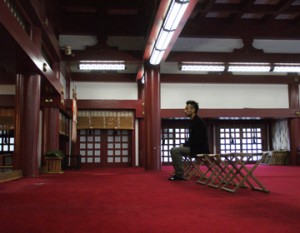The Yoshino River, one of the largest rivers in Shikoku, flows through Tokushima Prefecture from west to east. Mima City, located in the basin of the Yoshino River, is home to Hongakuji Temple, a temple founded in the early Heian period (794-1185). The temple has two unique gardens: a karesansui (dry landscape garden) with the majestic flow of the Yoshino River as a backdrop, and a kaiyushiki (circular garden) that makes use of the natural mountain surface.
Location overlooking the nature of western Tokushima
The Shikoku Mountains are a series of 1,000-meter-high mountains in the central part of Shikoku. Many of these mountains, including Tsurugisan (Mt. Tsurugi), one of Japan’s 100 most famous mountains, have long flourished as sacred peaks of mountain worship. Hongakuji Temple is a temple of the Mimuro school of Shingon Buddhism located in Anabuki Town, Mima City, Tokushima Prefecture, in the middle reaches of the Yoshino River, which crosses the Shikoku Mountains. The temple stands on a hill with a fine view overlooking the Yoshino River, which flows freely through the area.
A Shingon temple that served as a fortress during the Warring States Period
Hongaku-ji Temple was founded in 828 by the monk Eun as a Shingon dojo, and was later revived in 1131 by the monk Yujun. The temple is said to have been used as a fortress during the Warring States Period because of its location on a hill with a river in front and mountains in the background. After climbing a steep slope and passing through the temple gate, the beautifully landscaped grounds spread out before one’s eyes, reminding one of a “natural fortress. To the right is a view of the Karesansui (dry landscape garden) and the Yoshino River, to the left is the Kyakuden (guest hall), and beyond the stone pavement in front of the main hall is the main hall.
The main hall is built in the kake-zukuri style, taking advantage of the topography.
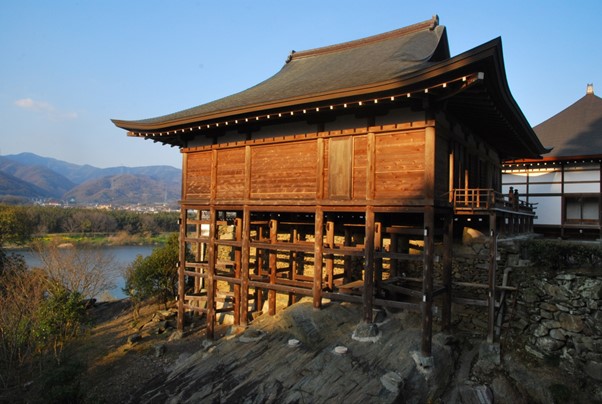
During the Azuchi-Momoyama period (1568-1600), the temple was burned down in a military fire by the Chosokabe clan, and was again destroyed by fire in 1863, only to be rebuilt the following year by the monk Yukiei. Currently, the temple grounds include the main hall, gomado, Tenjinsha, Kyakuden, and a tea ceremony room, all of which were rebuilt or repaired in the Heisei period or later. The main hall and gomado were built using a traditional construction method called kakezukuri. For a common example, think of the main hall of Kiyomizu-dera Temple in Kyoto. It is a spectacular sight, standing tall atop a latticework of long pillars and beams from the bottom of a cliff.
The statue of Amida Nyorai that survived the war
The temple was the family shrine of the Hachisuka clan, the feudal lord of Tokushima in the Edo period (1603-1868), and is dedicated to the wife of the clan’s founder, Masakatsu Hachisuka, and to the descendants of the Inada clan, the feudal lord’s retainers.
The main hall is a wooden structure made of Aomori cypress, and a statue of Amida Nyorai is enshrined as the principal image. The statue is 45 cm tall and has an impressive expression that is both soft and stern. There were many other treasures in the hall, but they were lost in a recent military fire. The hall also houses the Daisho Junkiten, a secret statue of Buddha said to have been handed down from Ienobu Tokugawa, the 6th Tokugawa Shogun, as well as Buddhist paintings.
Two gardens as the face of the temple
Although Hongaku-ji Temple has a long history, most visitors to the temple today probably come for its beautiful garden. Karesansui (dry landscape garden) and kaiyushiki (circular garden). These two distinctive gardens were created by Tadakazu Saito, an expert on ancient gardens and temple grounds. He has created, supervised, and restored gardens all over Japan, including the Ueda Sokyu School Iemoto’s open-air garden in Hiroshima, the Shoujuin garden in Shizuoka, and the “Tsukuhano Garden” at the Hirozawa Museum of Art in Ibaraki. The temple garden is said to have been created by Mr. Saito in the late Showa period or early Heisei period.
Originally, there was a dry landscape garden created by a gardener from a parishioner’s family, but my father, who was the former head priest, asked Mr. Saito to create the garden because he wanted to make the temple more inviting,” said Yugen Yoshida, the temple’s head priest.
The only one of its kind in Japan? Stone garden with the river in the background
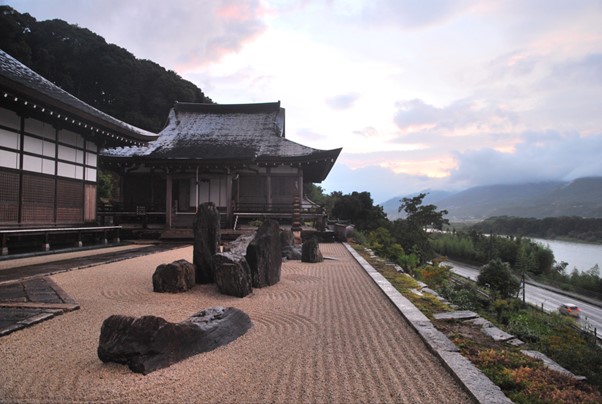
Karesansui refers to a form of garden that expresses natural scenery without using any water. The dry landscape “Tsurukame-no-niwa” at Hongaku-ji Temple is a garden with the view of the Yoshino River running right in front of it and the Asan Mountains stretching behind it as its borrowed scenery. It would not be an exaggeration to say that this is the only garden in Japan that uses the river as a borrowed landscape rather than the mountains. Based on Chinese Taoist philosophy, the garden is composed mainly of white sand representing water and stone arrangements resembling cranes and turtles. The blue stones unique to Awa are used, and from the left toward the Yoshino River, the turtle masonry, the crane masonry, and the boat stone carrying the miracle medicine of immortality are arranged. The cranes and turtles are represented as heading toward the multiple pagodas representing Horai Island on the far left, which expresses the wish for longevity, prosperity, and celebration.
Selected as one of the 88 scenic spots in Shikoku
The “crane and turtle garden” was created to look most beautiful when viewed from the guest rooms. Looking around the garden from the corridor of the guest room. The dynamic stone formations contrast with the white sand with sand patterns representing ripples, running water, and whirlpools. The magnificent view of the Yoshino River overlaps with this, drawing you into a spacious and expansive worldview that is somewhat continental. The view from here has been selected as one of the 88 Views of Shikoku, a project to designate and promote the attractiveness of the unique landscapes and townscapes of Shikoku. The atmosphere is especially nice on rainy days,” says Yoshida.
The beauty of a garden with greenery and rock surfaces
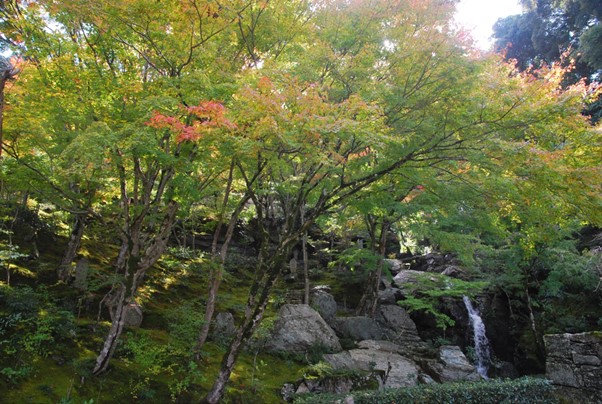
Moving along the grounds toward the mountain side, there is another garden, the Kaiyushiki Garden. This garden makes full use of the terrain of the rugged mountain surface, with masonry, stone steps, and plantings, creating a landscape that looks like a miniature of the great outdoors. At the center of the garden is the Ryumonbaku Waterfall and Rigyoseki, a waterfall masonry structure that utilizes the original rock surface. Stone steps and small paths are built around the waterfall, which has a drop of about 6 meters, and a stone bridge at the top of the waterfall allows visitors to walk around the waterfall. Incidentally, “Longmen Fall” refers to the style of stonework associated with the Chinese legend “Xinglongmen,” in which a carp climbs up a waterfall on the Yellow River to become a dragon.
In the garden, the solemnity of the natural rocks and masonry is harmonized with the greenery of moss and trees covering the slopes, and visitors can immerse themselves in the beauty of the garden, which purifies the mind. The garden is also home to many maple trees, which create a gorgeous atmosphere during the fall foliage season.
Relax in a tea house built on a bedrock
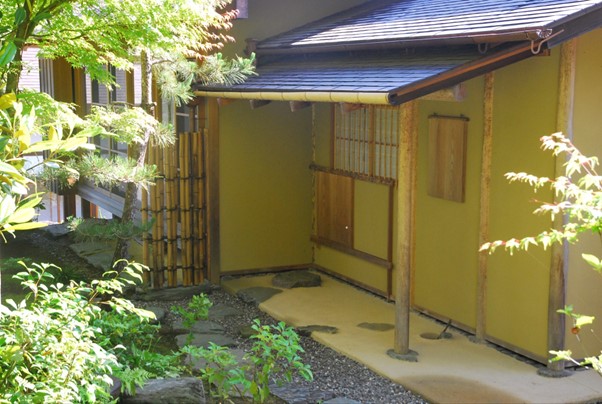
Walking along a small path from the top of the waterfall, you will reach Hifumi An, a tea house in the sukiya style. Visitors enter the tea house through an atmospheric open space with the aforementioned blue stones as paving stones. The building is built on a large rock face, so the large windows offer a panoramic view of the powerful rock face, the main hall, the guest house, and the garden below.
The refreshingly decorated tearoom can be used for formal tea ceremonies or for a casual sip of green tea. With the colors of the season in the background, you can savor carefully prepared matcha green tea and tea cakes, and relax in the slow flow of time.
Enjoy vegetarian cuisine with all your senses.
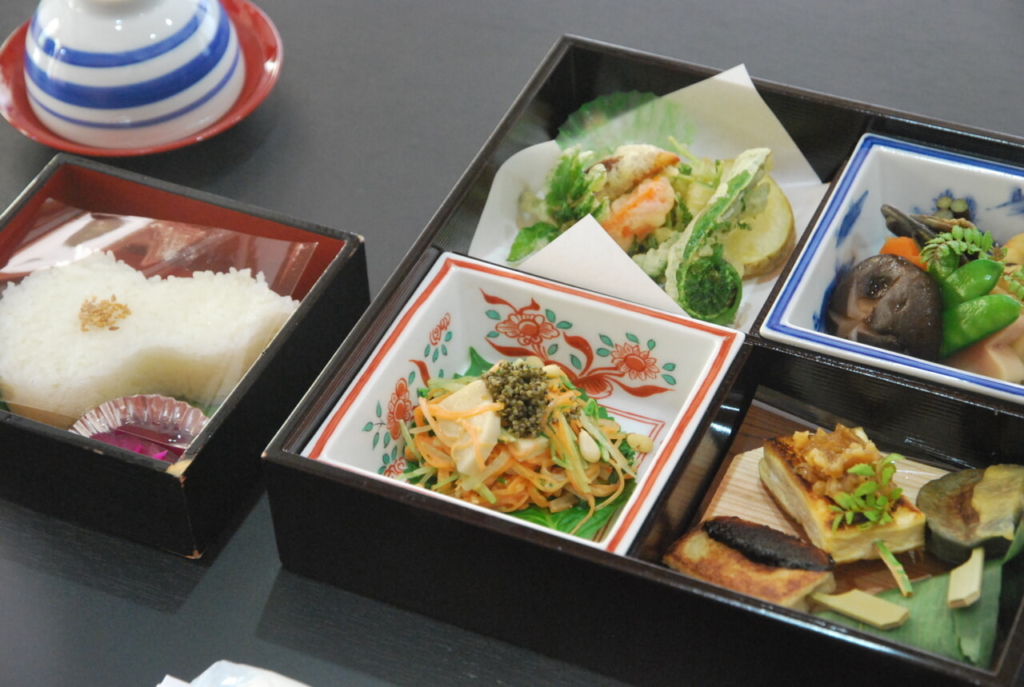
What makes the cuisine even more appealing at Honrakuji is that it is deeply personal. Each Kaiseki vegetarian dish, carefully prepared to maximize the flavor of seasonal vegetables, is like a work of art. The elegant flavors reflect the seasons, and the dishes will leave you with a sense of peacefulness and richness.
I believe that a temple must have a charm that people love. I want to contribute to the improvement of the arts and the happiness of people through gardens and cuisine.” Mr. Yoshida, who puts these ideas into practice, continues to work tirelessly on his garden under the direction of Mr. Saito. He is also a chef himself.
A space where you can reflect on yourself and want to visit again and again
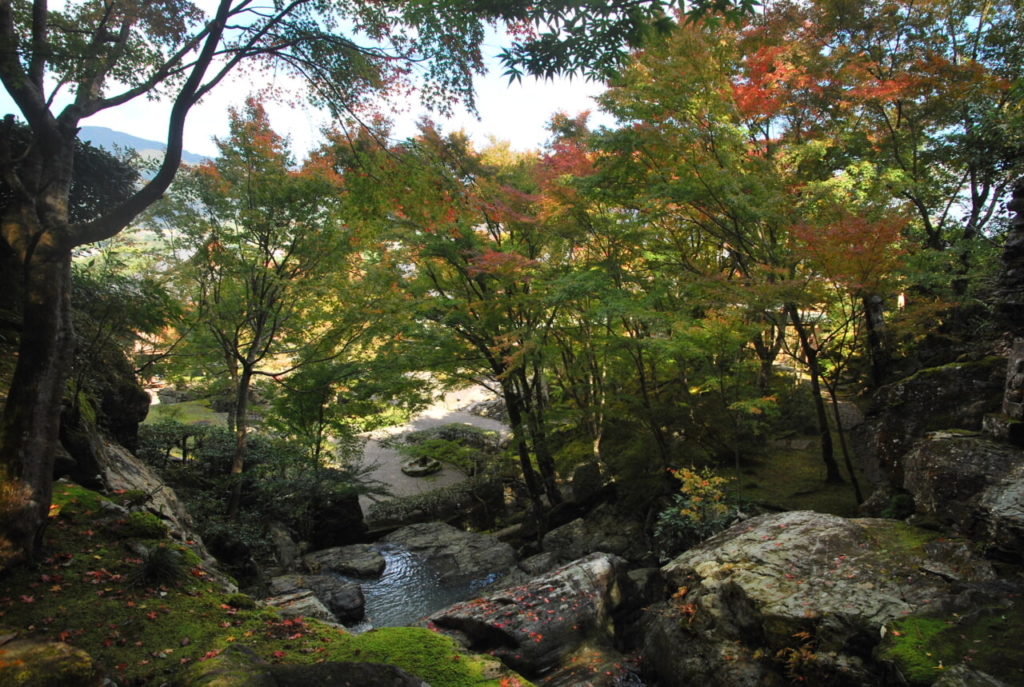
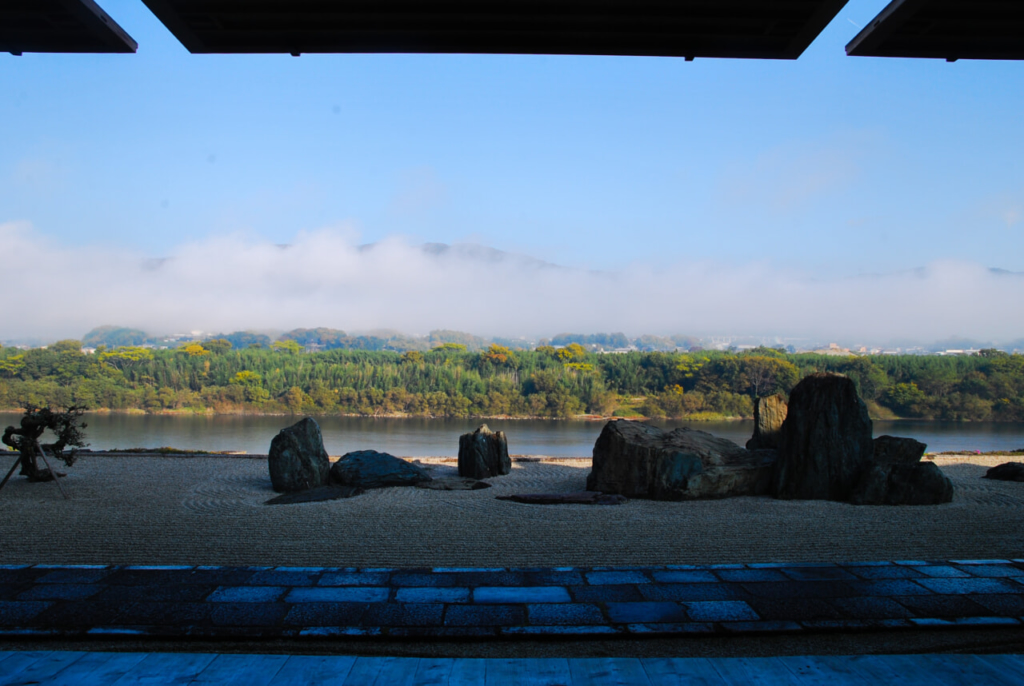
A garden tells many spiritual stories, and gardeners put many meanings into their gardens. (Therefore, it is important to see a garden over and over again. It is the same act as reading a good novel over and over again.
This is a passage in which Mr. Saito talks about how a garden should be. The Honrakuji Temple, a beautiful collaboration of seasonal nature and human creation, is a place where you will find something new no matter how many times you visit, and each time you visit, you will be able to look at yourself again.



